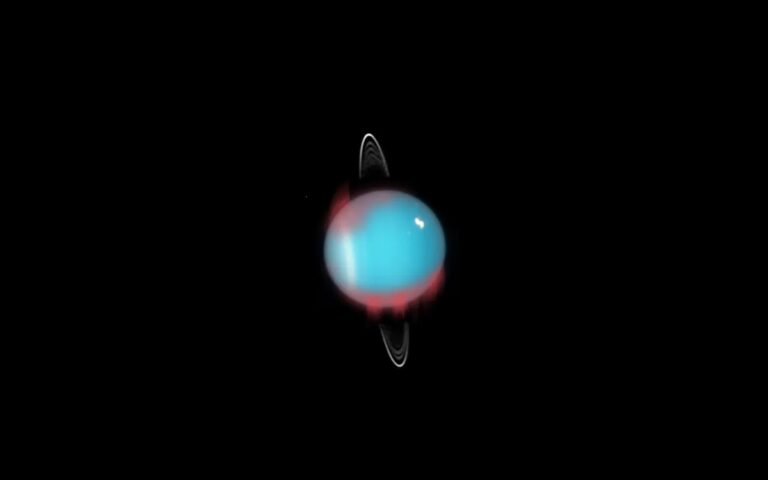Astronomers have verified the existence of an infrared aurora on Uranus.
The discovery of auroras on Uranus offers insights into potentially habitable frigid worlds.
Uranus, the frigid outermost planet in our solar system, exhibits a curious misalignment between its magnetic field and rotational axes. While the origin of this phenomenon remains a puzzle, it is suggested that the answer may be found in the enigmatic auroras of Uranus.

Auroras are produced when highly charged particles plunge into a planet’s atmosphere along its magnetic field lines, emitting light in various wavelengths, including infrared (IR), beyond the visible spectrum. Given that Uranus is primarily composed of hydrogen and helium, its auroras predominantly manifest in the form of infrared emissions.
Researchers from the University of Leicester employed the Keck II telescope to analyze specific infrared wavelengths of light emitted by Uranus’s aurora. Their observations marked the first confirmation of the presence of an infrared aurora on Uranus, potentially shedding light on the origins of planetary magnetic fields in our solar system and the potential habitability of distant worlds.
The emitted light, resembling a barcode of sorts, was analyzed to derive crucial information about the planet. Parameters like the temperature of charged particles known as H3+ and the density of the atmospheric layer significantly influenced the brightness of the infrared emission lines. As such, these lines essentially act as a thermometer for the planet.
The scientists’ observations revealed significant variations in H3+ density in Uranus’s atmosphere, which aligns with the ionization effects induced by an infrared aurora. This discovery enhances our understanding of the magnetic fields surrounding the outer planets within our solar system and provides valuable insights for identifying planets that might be suitable for sustaining life.
Lead author Emma Thomas, a Ph.D. student at the University of Leicester School of Physics and Astronomy, postulated, “The gas giant planets, including Uranus, exhibit temperatures hundreds of degrees above what solar warming alone would predict, raising the intriguing question of what generates this excess heat. One hypothesis posits that energetic auroras play a role by generating and transporting heat from the aurora to the magnetic equator.”
She further added, “Most exoplanets discovered to date fall within the sub-Neptune category, sharing similarities in size with Neptune and Uranus. This suggests potential parallels in their magnetic and atmospheric characteristics. By studying Uranus’s aurora, which is intricately linked to the planet’s magnetic field and atmosphere, we can make informed predictions about the atmospheres and magnetic fields of these distant worlds and their suitability for sustaining life.”
Thomas also emphasized, “This research represents the culmination of 30 years of auroral investigations on Uranus, finally unveiling the enigmatic infrared aurora and initiating a new era of aurora research on this distant planet. Our findings will expand our knowledge of ice giant auroras and bolster our understanding of planetary magnetic fields in our solar system, at exoplanets, and even on Earth.”
Furthermore, Thomas raised concerns about the potential implications of this phenomenon, stating, “We have limited knowledge about this phenomenon and its possible effects on systems reliant on Earth’s magnetic field, such as satellites, communications, and navigation. However, Uranus experiences this process daily due to the unique misalignment of its rotational and magnetic axes. Ongoing research into Uranus’s aurora can provide insights into what we can anticipate when Earth undergoes a future magnetic pole reversal and how that may impact its magnetic field.”
Journal Reference:
- Thomas, E.M., Melin, H., Stallard, T.S. et al. Detection of the infrared aurora at Uranus with Keck-NIRSPEC. Nat Astron (2023). DOI: 10.1038/s41550-023-02096-5
Do not forget to share your opinion with us to provide you with the best posts !




0 Comments